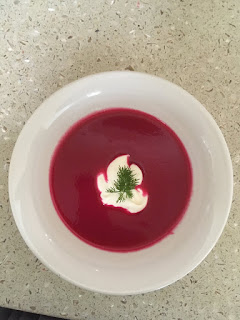Not everything was wrecked although the rainbow chard is somewhat mangled as are some of the cabbages and lettuces but one vegetable seems to have survived well and that's the beetroot as you can see.in this photo showing of part of the beetroot bed.
You've probably guessed from this that Pisces and I like eating beetroot. Both the roots and the leaves regularly make their way into our meals and are shared with our neighbours. I grow a mix of traditional red beetroot and other variously coloured heritage varieties which is why this bowl of borscht, made from a mix of red, yellow, cream and pink beets, is more pink than the usual red. It's just as tasty, though.
Borscht isn't the only way I use beets of course. The roots are delicious as vegetables baked, steamed or boiled, you can use them in cakes and raw grated into salads or processed into vegetable smoothies while the leaves can be steamed, braised or microwaved with the tender young leaves a lovely addition to a leafy salad. It's a vegetable that just keeps on giving.



4 comments:
That soup looks great. Thankfully the farm wasn't so affected.
https://www.melodyjacob.com/2020/08/name-change-after-marriage-tradition.html
It is a real shame that having invested so much time and effort into the peas you have lost them. I haven't had borscht for a long time, but your picture gives me a hankering for it. It used to be a staple many years ago in the old European Jewish delis and a common expression for something that didn't cost too much was "Cheap like borscht!"
It tasted a sgreat as it looks, Melody.
Davifd I'm sad about the loss of the peas just as they were starting to produce but at least most of the rest of the garden survived fairly well. We both love borscht and have it hot in winter and cold in summer. It may be cheap but it's certainly tasty.
Post a Comment